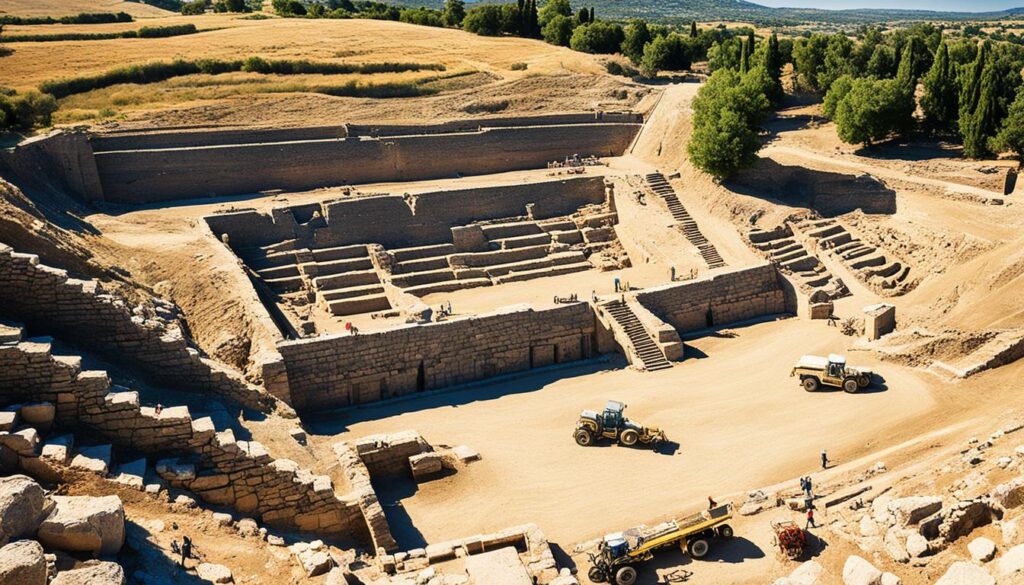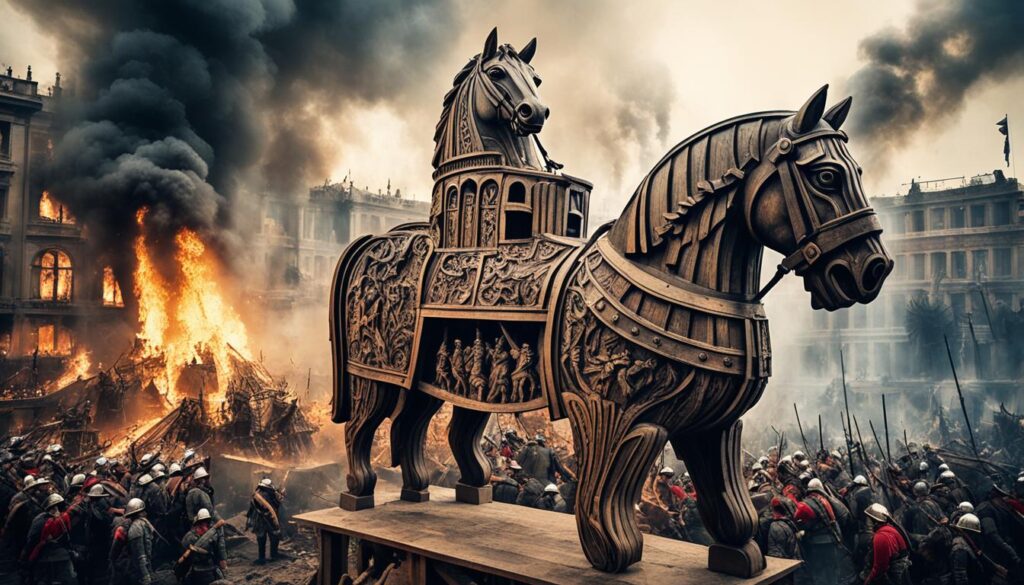The Trojan Horse is a legendary tale from Greek mythology that has captured hearts for centuries. Was it just a story, or did it really change the outcome of the Trojan War? Let’s look into the history and evidence to find out the truth about this famous tale of war strategy.
The Trojan War was a battle between the Greeks and the city of Troy, full of mystery and intrigue. The Trojan Horse was a huge wooden structure that, legend says, helped the Greeks sneak into and defeat Troy. But was this clever tactic just a myth, or did it really happen?
Exploring the myths, archaeology, and history of the Trojan War and the Horse reveals a fascinating story. It shows how deception in war, the power of stories, and the lasting impact of this tale. Let’s dive into the facts and fiction of the Trojan Horse, a symbol of cleverness and strategic thinking that has lasted through the ages.
The Legendary Tale of the Trojan War
The Trojan War is a legendary conflict that has captured the hearts of people for centuries. It is immortalized in ancient Greek epics, like Homer’s Iliad and Odyssey. These works give us a vivid look at the events of this key moment in history.
Ancient Greek Epics and Their Impact
The Iliad and the Odyssey, by the famous Greek poet Homer, are seen as some of the greatest literature ever written. They tell the story of the Trojan War and explore complex relationships, heroic acts, and tragic outcomes. The lasting effect of these epics shows their deep impact and the power of stories to shape our view of the past.
Key Players in the Trojan Conflict
The Trojan War had legendary figures, each with their own roles and reasons. Achilles, a Greek warrior, was unmatched in valor and skill. Hector, a brave Trojan prince, defended his city with great courage. Paris, a Trojan prince, took Helen of Troy, starting the war that led to Troy’s downfall. These characters and their stories have fascinated people for thousands of years, making the Trojan War a timeless tale of heroism and the effects of human actions.
The Mythical Wooden Horse Strategy
The Trojan Horse tale is a key part of military history. It shows a clever trick used by the Greeks during the siege of Troy. This trick helped bring down the ancient city, making the Trojan Horse famous.
The Greeks were stuck for years trying to get past Troy’s strong walls. Odysseus, the Greek leader, came up with a plan to use the Trojans’ own confidence against them. They built a huge wooden horse that could hide a group of their best soldiers inside.
Next, the Greeks pretended to leave, leaving the wooden horse as a “gift” for the Trojans. The Trojans thought they had won and brought the horse into their city. But at night, the Greek soldiers came out of the horse and opened the gates. This let the Greek army in, leading to the fall of Troy.
This strategy showed the Greeks’ skill in trickery and their readiness to think outside the box. The Trojan Horse has become a symbol of the strength of deception. It teaches us to always be alert, even when things seem safe.
Separating Fact from Fiction
The Trojan War and the story of the Trojan Horse have fascinated people for centuries. These tales are part of Greek mythology, but scholars debate their historical truth. Looking at archaeological and historical evidence helps us understand if these stories might be true.
Historical Evidence for the Trojan War
Archaeologists have found evidence of a big conflict at ancient Troy in modern Turkey. They found artifacts and layers of destruction that show a major battle happened. This supports the story of the Trojan War.
Old Hittite records also talk about a kingdom called “Wilusa,” which might be Troy. These records show political and military dealings between the Hittites and Wilusans. This adds to the idea that the Trojan War might have really happened.
Even though the details of the Trojan Horse are legendary, the evidence and records we have suggest a big conflict did occur in the Bronze Age. This makes the Trojan War seem more real.

Archeological Discoveries at Troy
The ancient city of Troy has always fascinated scholars and history lovers. Renowned archaeologists have slowly uncovered its secrets. This has shed light on its rich past and its link to the legendary Trojan War.
Uncovering the Ancient City’s Secrets
Heinrich Schliemann, a German archaeologist, led major excavations at Troy in the late 19th century. His hard work paid off when he found the ruins of what he thought was the legendary Troy. He found many artifacts like pottery, jewelry, and fortification remains.
Since then, both German and Turkish archaeologists have kept digging. They’ve found many layers of occupation going back to the Bronze Age. These discoveries have given us a lot of information about the city’s architecture, trade, and life.
They found the city’s walls, gates, homes, and shops. Each new find has helped us understand Troy better. It shows us what life was like in the ancient world.
The digs at Troy have confirmed the city’s existence and given us new insights into the Trojan War. The artifacts and buildings found match parts of the Homeric epics. This makes the legendary war and its heroes more believable.
As we keep exploring Troy, we’re excited to see what other secrets it holds. Researchers and historians can’t wait to learn more about this ancient civilization.
The Enduring Legacy of the Trojan Horse
The Trojan Horse has become a symbol that goes beyond its ancient Greek roots. It has taken on a life of its own in culture, language, and politics. This legendary wooden structure was once a clever military trick in the Trojan War. Now, it’s a powerful metaphor and idiom that still fascinates us today.
The story of the Trojan Horse shows the power of deception and the lasting impact of ancient myths. Today, we use “Trojan Horse” to describe any situation where something looks good but has a hidden, bad reason. This idea is used in many areas, like computer security and political strategies.
The Trojan Horse has also made a big impact on culture. It has been retold and reimagined in many books, art, and movies. This keeps its status as a timeless and iconic story. From Homer’s epic poems to today’s movies, the Trojan Horse keeps inspiring and captivating people all over the world.
The lasting effect of the Trojan Horse shows how powerful myths can be. It’s a symbol of deception, cleverness, and the dangers of being too proud. The Trojan Horse keeps being a relevant and thought-provoking metaphor. It helps us understand human nature better.
Historical Curiosities: The Trojan Horse Myth
The story of the Trojan Horse is more than just an ancient battle tale. It’s filled with historical curiosities and legends that have fascinated people for ages. These lesser-known facts and stories give us a peek into the ancient world’s mysteries.
There’s a big debate about what the Trojan Horse really was. Some think it was a huge wooden structure, but others believe it could have been a siege engine or a symbol of a god. These ideas make the story even more intriguing, keeping us hooked on the Trojan Horse’s history and myth.

Over the years, the Trojan Horse has been retold in many ways. From ancient Greek stories to modern adaptations, each version gives us a fresh look at the legendary event. These stories have made the Trojan Horse a symbol of trickery, cleverness, and the power of our imagination.
Looking closer at the Trojan Horse, we find many interesting facts about the ancient world. Some think the horse was a clever way to get into Troy, while others see it as a sacred symbol in Greek mythology. These ideas help us understand the Trojan Horse better, both as a historical event and a cultural symbol.
Exploring the Trojan Horse myth shows us how legends and history can blend together. The Trojan Horse is a reminder of our fascination with the ancient world and its stories. It proves that the human mind can turn historical events into captivating tales.
The Art of Deception in Warfare
The Trojan Horse is a top example of military trickery in history. But it’s not the only time strategy has been used to win battles. Throughout history, leaders have used famous military ruses to beat their enemies. These tricks have changed the course of many wars, showing how deception is key in military strategy.
Famous Military Ruses Through the Ages
The ancient Chinese general Sun Tzu used Trojan Horse tactics early on. In “The Art of War,” he stressed the value of deception and surprise for victory. He advised to seem weak when strong, and strong when weak. His followers applied this strategy, using new military strategies to trick their foes.
Another example from World War II is the Allies’ use of “dummy” tanks and planes. With the Germans having more troops, the Allies created fake tanks and airfields. This “Operation Fortitude” helped the Allies win the D-Day battle and the war in Europe.
Deception isn’t just for ancient or modern wars; it’s been used by many leaders. From the Mongols to the American Civil War, the Trojan Horse strategy has been a key tactic. It shows how important deception is in warfare.
Symbolism and Metaphors of the Trojan Horse
The Trojan Horse has grown beyond its role in the Trojan War. It’s now a symbol in culture, literature, and language. This ancient story now means a lot, showing themes like deception, smart planning, and the risks of being too trusting.
The Trojan Horse stands for subtlety and trickery. The idea of hiding a danger in something that looks harmless is well-known. In stories and cultural references, it warns us not to relax, even when things seem safe.
In business, the Trojan Horse talks about secret tactics or hidden plans. It tells us to look beyond what seems friendly. We should check out proposals or ideas that seem too good to be true.
In politics, it’s used to talk about sneaky ways to bring in new ideas or weaken current systems. This reminds us to stay alert and think about the real reasons behind actions or plans.
The Trojan Horse’s lasting impact comes from its ability to connect with people across different cultures and times. It’s a symbol of trickery, smart planning, and the dangers of being too easygoing. This has made it a timeless and widely recognized metaphor.
Trojan Horse Retellings in Literature and Art
The story of the Trojan Horse has been a big hit with artists and writers for centuries. It has led to many different stories and artworks. Each one gives a new look at this classic tale.
Timeless Interpretations of the Ancient Tale
In literature, the Trojan Horse is a big deal. Authors use the ancient myths to make their own stories. Works like Homer’s “Odyssey” and Virgil’s “Aeneid” show how the Trojan Horse is used to talk about trickery and war.
Today’s writers also love the Trojan Horse. They use it in their stories to show how smart and creative characters can be.
Artists have also been drawn to the Trojan Horse. They’ve made many artworks, from paintings to sculptures, based on this story. These works show how the Trojan Horse has changed over time. It’s now a symbol that inspires and fascinates people all over the world.






